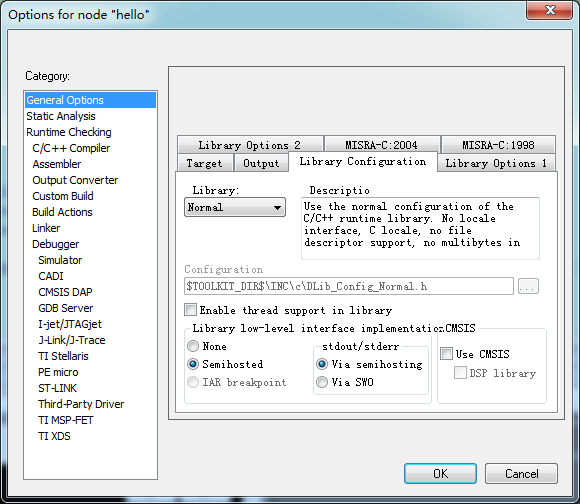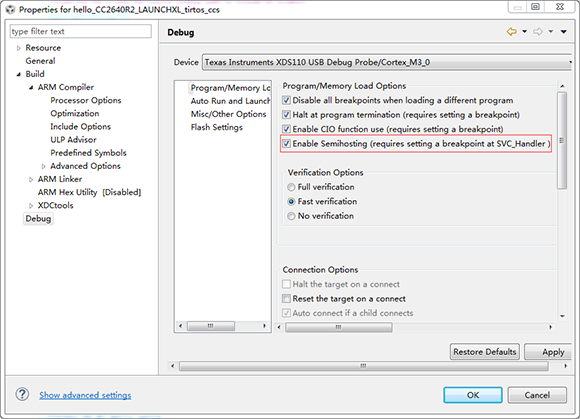CC1310 私有协议、TI-15.4、Contiki 开发
关于我们
入门开始
视频教程
CC1310平台
外设驱动
私有协议
TI-15.4(基于802.15.4g)
Contiki
工具集
其他
CC1310 私有协议、TI-15.4、Contiki 开发
关于我们
入门开始
视频教程
CC1310平台
外设驱动
私有协议
TI-15.4(基于802.15.4g)
Contiki
工具集
其他
IAR和CCS都支持一种Semi-Hosting技术(半独立主机),这对产品早期开发的使用 printf和 System_printf 是非常方便的,轻易将调试信息打印在IDE的终端。但是一旦Semi-Hosting 使能,绝大的TI-RTOS例程在没有连接的IDE到时候不会运行,主要是因为类似 System_flush() API 需要等待IDE应答。区别其他IDE,CCS的握手机制不太一样,通过CCS编译生成的工程可以独立IDE运行。
对于Semi-Hosting,我们参考以下模型理解

本文以下CC2640R2F BLE5.0 SDK下面的 C:\ti\simplelink_cc2640r2_sdk_1_40_00_45\examples\rtos\CC2640R2_LAUNCHXL\sysbios\hello 工程为例,介绍如何使用SemiHosting支持的System_printf用以打印调试信息。
在IAR 导入Examples已经详细讲解如何导入Examples,参考它,导入Hello 例程。
在Main函数中,以下代码段实现主要功能:
int main() {
/* Call driver init functions */
Board_initGeneral();
System_printf("hello world\n");
/*
* normal BIOS programs, would call BIOS_start() to enable interrupts
* and start the scheduler and kick BIOS into gear. But, this program
* is a simple sanity test and calls BIOS_exit() instead.
*/
BIOS_exit(0); /* terminates program and dumps SysMin output */
return(0);
}对于以上代码的System_printf("hello world\n");需要借助仿真器Debug的时候在Terminal打印。
IAR-View->Terminal I/O

注意:这里的终端打印只有在借助仿真器在线调试打印,并且离开IAR,复位可能不能正常运行。
CCS的Console 比较明显
Window->Show View->Console.

对于独立工程,我们又该怎么去禁止和使能呢?
对于IAR,使能支持(Semihosted)或者禁止(None)
Project>Options>General Options>Library Configuration>Semihosted

CCS则通过以下选择;
Project>Properties>Debug>Enable Semihosting(requires a breadpoint at SVC_Hnadler)
 )
)
同时需要工程配置文件hello.cfg使用 SysMin模块,同样地可以通过SysCallback重映射IO到我们指定的打印接口(比如串口)来禁止改功能;
/*
* The System.SupportProxy defines a low-level implementation of System
* functions such as System_printf(), System_flush(), etc.
*
* Pick one pair:
* - SysMin
* This module maintains an internal configurable circular buffer that
* stores the output until System_flush() is called.
* The size of the circular buffer is set via SysMin.bufSize.
* - SysCallback
* SysCallback allows for user-defined implementations for System APIs.
* The SysCallback support proxy has a smaller code footprint and can be
* used to supply custom System_printf services.
* The default SysCallback functions point to stub functions. See the
* SysCallback module's documentation.
*/
var SysMin = xdc.useModule('xdc.runtime.SysMin');
SysMin.bufSize = 512;
System.SupportProxy = SysMin;
//var SysCallback = xdc.useModule('xdc.runtime.SysCallback');
//System.SupportProxy = SysCallback;
//SysCallback.abortFxn = "&myUserAbort";
//SysCallback.exitFxn = "&myUserExit";
//SysCallback.flushFxn = "&myUserFlush";
//SysCallback.putchFxn = "&myUserPutch";
//SysCallback.readyFxn = "&myUserReady";如果使能了SemiHosting,需要#inlucde以下文件防止编译错误:
/* XDC Module Headers */
#include <xdc/std.h>
#include <xdc/runtime/System.h>What is semihosting?
TI-RTOS Examples SemiHosting
文章所有代码、工具、文档开源。加入我们QQ群 593145299获取更多支持,共同研究Contiki应用和TI-15.4Stack。